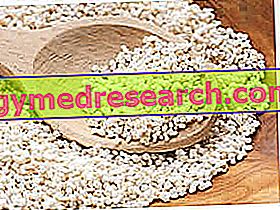Amaranth
Amaranth is a plant-based food that belongs to the group of cereals *.
It has Central American origins, where it has been cultivated since ancient times; with the Spanish colonization of these places, the production of amaranth has diminished, so much so that today it is a fairly obsolete product (especially in the rest of the globe).

Amaranth DOES NOT CONTAIN GLUTEN and for this reason it is perfectly "gluten-free" for the treatment of celiac disease; in addition to this feature, the amaranth boasts nutritional properties worthy of greater attention.
Amaranth can be consumed whole or in the form of flour (the leaves are used in the formulation of decoctions or as a leafy vegetable).
Amaranth flour
Generally speaking, being an "alternative" or "naturist" product, amaranth flour is derived from seeds of plants obtained by organic cultivation.
The "milling" process is similar to that used for conventional cereal flours. There is no detailed information regarding what concerns possible sifting processes but, in various texts, the nutritional values of the flour are superimposed on those of the whole seeds; this "should" imply that it is a 100% integral product. It is however necessary to remain with the "benefit of the doubt", since it should not be possible to produce a flour with a reasonable conservative potential WITHOUT the seeds being deprived of the germ (containing easily oxidizable lipids) and WITHOUT adding additives!
Not containing gluten, amaranth flour is not suitable for the production of leavened foods. At the most, it can be mixed with wheat (or other gluten cereals) in a ratio of 50-80% wheat and 50-20% amaranth.
Being highly aromatic, amaranth flour is instead useful in the formulation of biscuits, Ethiopian bread ( injera, similar to a crepe) and Indian bread ( chapati - similar to a piadina).
The table below shows the nutritional values of the amaranth flour produced by a company that complies with the BIO regulations.
| Average nutritional values per 100g of product | |
| Energy value (Kcal) | 321 |
| Proteins (g) | 14.5 |
| Carbohydrates (g) | 51 |
| Fats (g) | 7.1 |
| Fibers (g) | 15 |
| Iron (g) | 7.61 |
| Calcium (mg) | 159 |
As can be seen from the reported values, amaranth is a food that supplies more or less the same energy as whole grains. For its part, it contains excellent doses of fiber, a greater quantity of lipids (up to 7 times higher than the equivalent of whole wheat), surprising portions of calcium (5 times as much) and iron (twice as much). Details on the breakdown of fatty acids and the overall vitamin profile are not available.
Gluten Free Amaranth Dumplings with Butter and Sage
X Problems with video playback? Reload from YouTube Go to Video Page Go to Video Recipes Section Watch the video on youtube



